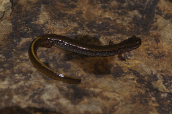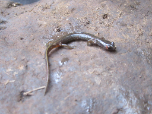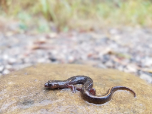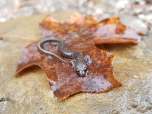 |
Oklahoma Salamander Range Map
|
|
|
 |
 |
 |
 |
 |
 |
 |
Oklahoma Salamander Larva

|
|
|
 |
 |
 |
 |
 |
 |
|
Oklahoma Salamander (Eurycea tynerensis)
Description: The Oklahoma salamander is a small, dark, slender salamander that is generally yellowish tan to dark brown or gray. The stripe running along the back may be golden or yellowish tan to brown and is bordered by dark brown lines. Also along back, there may be a row of dark brown V-shapes corresponding to each of the 19 to 21 costal grooves (vertical grooves on the sides of the body). The sides and tail have small white flecks. The belly is gray but may be somewhat yellow.
Most commonly, however, this species is seen only in its gilled, aquatic larval stage or as neotenic adults (adults that retain gills). In these, the back and sides are cream or light tan and covered with extensive gray stippling, with two lines of small white spots along the sides, and a pale belly. Poorly developed dorsal and ventral fins are present on the tail.
Habitat: Both larval and adult life stages are permanently aquatic, and most of the population live in small, clear, cherty, gravel-bottom creeks, streams, and springs. When surface water is present, these salamanders live in the spaces among loose gravel or under rocks. During dry periods and presumably during the winter, these salamanders follow the water level down into the creek gravel bed; using this type of aquatic habitat allows them to remain active all year.
Range: The Oklahoma salamander has a restricted distribution in Missouri, Oklahoma, and Arkansas, but it appears to be relatively secure in Missouri.
Found in these States:
AR |
MO |
OK
Diet: Small arthropods are the primary food of both adults and larvae, especially ostracods (seed shrimp), isopods (such as aquatic pillbugs), dipterans (true flies, including their aquatic, wormlike larvae), and ephemeropterans (mayflies, including their aquatic larvae).
Reproduction: Neoteny is common in this species; this means that adults retain the feathery external gills that generally characterize the larval stage; thus the adults remain permanently aquatic. It is very rare to find an adult of this species that has fully transformed into a gill-less form.
Fertilization is internal, and females attach their eggs to the undersurface of rocks or within spaces in the gravel substrate of springs and streams. Females lay 3 to 21 eggs. Incubation lasts about 30 days. Larvae are gilled. After 5 to 8 months, the larvae become sexually mature. Most adults will be neotenic (retaining the gilled, aquatic form), while a few may transform into the gill-less adult form more typical of this family. Neotenic adults generally attain larger sizes than those that undergo the full metamorphosis.
The reproductive season varies considerably within the range of this species due to temperature variation among breeding sites. Places where the temperature is fairly stable, such as in cave streams and springs, have prolonged reproductive seasons. Places where the temperature fluctuates widely, such as in surface streams, have briefer reproductive seasons. Generally, breeding may last from September into July, with many populations laying eggs during the fall to late spring.
Status: Listed as Least Concern in view of its relatively wide distribution, presumed large population, and because it is unlikely to be declining fast enough to qualify for listing in a more threatened category.
»» Kingdom: Animalia - Animals
»» Phylum: Chordata - Chordates
»» Subphylum: Vertebrata - Vertebrates
»» Class: Amphibia - (Amphibians)
»» Order: Caudata - Salamanders
»» Family: Plethodontidae - Lungless Salamanders
»» Genus: Eurycea
»» Species: Eurycea tynerensis - Oklahoma Salamander
This article uses material from the Wikipedia article "Oklahoma Salamander", which is released under the Creative Commons Attribution-Share-Alike License 3.0. Content may have been omitted from the original, but no content has been changed or extended.
|
|













